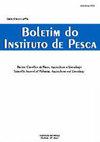ANTIMICROBIAL ACTIVITY OF ESSENTIAL OILS OF Origanum vulgare AND Ocimum basilicum AGAINST Vibrio parahaemolyticus AND Vibrio vulnificus AND ADDITION OF THESE OILS ON Mugil platanus FILLETS
IF 0.6
4区 农林科学
Q4 FISHERIES
引用次数: 0
Abstract
Species of the Vibrio genus are commonly reported as agents of food poisoning outbreaks associated with fish consumption. The objective of this study was to assess the antimicrobial activity of the essential oils of Origanum vulgare and Ocimum basilicum against Vibrio parahaemolyticus and Vibrio vulnificus, as well as to assess their addition to fillets of Mugil platanus and sensorial acceptance among consumers. The antimicrobial activity was analyzed by the disc diffusion test and minimal bactericidal concentration (MBC). M. platanus fillets, experimentally contaminated, were marinated for 24 hours in a solution containing 1.0% and 1.5% of essential oil of O. vulgare. For the sensory analysis, samples marinated in 1.5% of O. vulgare oil were prepared and offered to 100 testers. The oil of O. basilicum shows no antimicrobial activity, so its application would be ineffective; for such reason the subsequent tests were not performed. However, the essential oil of O. vulgare produced inhibition halo diameters ranging from 24.6 to 34.1 mm, on average, and the MBC ranging from 3.9% to 15.6%. When added to the product, the essential oil of O. vulgare eliminated the microorganisms that were experimentally inoculated. In the sensorial analysis, samples marinated in 1.5% of O. vulgare essential oil obtained an average of 6.82 of acceptance note among consumers.牛油和罗勒精油对副溶血性弧菌和创伤弧菌的抑菌活性及添加在平木鱼鱼片上的效果
弧菌属的种类通常被报道为与食用鱼类有关的食物中毒暴发的媒介。本研究的目的是评估寻常木和罗勒木精油对副溶血性弧菌和创伤弧菌的抑菌活性,以及评估它们在平头木鱼片中的添加量和消费者的感官接受度。采用圆盘扩散试验和最小杀菌浓度(MBC)对其抑菌活性进行了分析。将实验污染的桔黄鱼片在含1.0%和1.5%桔黄精油的溶液中浸泡24小时。为了进行感官分析,制备了1.5%的油浸泡样品,并提供给100名测试者。罗勒油无抑菌活性,应用效果不理想;因此,没有进行后续的测试。结果表明,精油的抑制晕直径平均为24.6 ~ 34.1 mm, MBC为3.9% ~ 15.6%。当加入到产品中时,野藿香精油消除了实验接种的微生物。在感官分析中,在1.5%的精油中浸泡的样品在消费者中的平均接受度为6.82。
本文章由计算机程序翻译,如有差异,请以英文原文为准。
求助全文
约1分钟内获得全文
求助全文
来源期刊

Boletim do Instituto de Pesca
FISHERIES-ZOOLOGY
CiteScore
0.80
自引率
0.00%
发文量
24
审稿时长
>12 weeks
期刊介绍:
To publish original articles of research and short communications in the following áreas: Fisheries, Aquaculture, Zootechnology, Limnology, Oceanography, Biology and Pathology of aquatic organisms. The publication depends on the approval of the Editorial Board, based on the peer review.
 求助内容:
求助内容: 应助结果提醒方式:
应助结果提醒方式:


